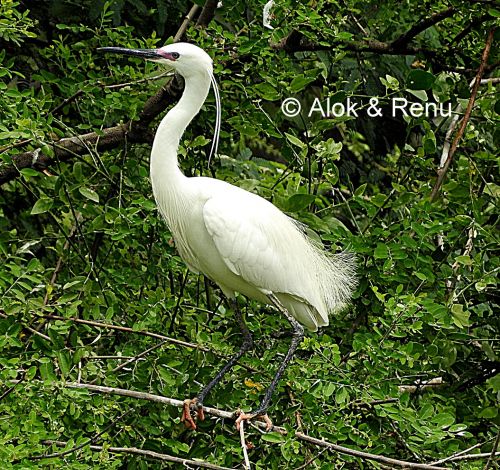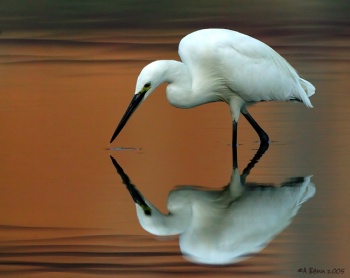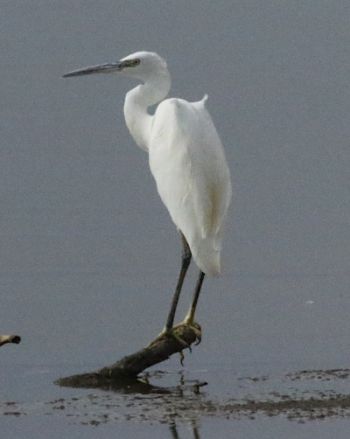(added dimorpha photo) |
|||
| (43 intermediate revisions by 12 users not shown) | |||
| Line 1: | Line 1: | ||
| + | [[Image:little_egret_alok.JPG|thumb|500px|right|Full breeding plumage, nominate subspecies<br />Photo © by {{user|aloktewari|Alok Tewari}}<br />[[Keoladeo National Park]], Bharatpur, [[india]], June-2015]] | ||
;[[:Category:Egretta|Egretta]] garzetta | ;[[:Category:Egretta|Egretta]] garzetta | ||
| − | [[Image:Little_Egret.jpg|thumb| | + | '''Includes: Dimorphic Egret, Black-footed Egret''' |
| + | ==Identification== | ||
| + | [[Image:Little_Egret.jpg|thumb|350px|right|Photo © by {{user|alibenn|alibenn}}<br />Beidaihe, [[China]], September 2005]] | ||
| + | (21¾-25½ in) 55–65 cm. A small white heron | ||
| + | *overall white | ||
| + | *legs and bill black | ||
| + | *feet yellow or black (''nigripes'') | ||
| + | |||
| + | '''Breeding:''' | ||
| + | *2 long slender plumes from the back of the head | ||
| + | *plumes on the back and breast. | ||
| + | *[[Topography#Heads|lores]] bright yellow, orange, or even flushed bright red (excited birds) in pre-breeding display | ||
| + | |||
| + | '''Non-breeding:''' | ||
| + | *[[Topography#Heads|lores]] are bluish-grey or yellow (''nigripes'') | ||
| + | *Breeding filo plumes absent | ||
| + | |||
| + | Juveniles differ in having no plumes, and drabber bare part colours, with dingy dark grey-green legs with more extensive dull blackish-yellow on the lower legs, a dark grey bill with a paler base, and dull grey lores. | ||
| + | ====Similar species==== | ||
| + | [[Image:P1740556RGp900n2.jpg|thumb|350px|right|Juvenile<br />Photo © by {{user|ChrisKten|ChrisKten}}<br />[[London]], [[UK]], June 2014]] | ||
| + | On Little Egret, the upper edge of the bare facial skin is straight from eye to bill, while in [[Chinese Egret]] that line goes down before going back up<sup>[[#References|[2]]]</sup>. See also [[Snowy Egret]] for comparison of that species with Little Egret<sup>[[#References|[3]]]</sup>. | ||
| − | |||
| − | |||
| − | |||
==Distribution== | ==Distribution== | ||
| − | From southern [[Europe]], though [[Asia]] to [[Korea]], [[Japan]], and [[Indonesia]] to [[New Guinea]], as well in northern and eastern [[Australia]], and [[New Zealand]]. | + | [[Image:Little Egret92.JPG|thumb|350px|right|Subspecies ''nigripes'' with yellow soles just visible<br />Photo © by {{user|Ken+Doy|Ken Doy}}<br />Wellington Point, [[Queensland]], [[Australia]], September 2014]] |
| + | From western and southern [[Europe]], though southern [[Asia]] to [[Korea]], [[Japan]], and [[Indonesia]] to [[New Guinea]], as well in northern and eastern [[Australia]], and [[New Zealand]]. | ||
| + | |||
| + | In recent years it has increased substantially in western Europe, with breeding first recorded in [[Great Britain]] in 1996, rising to around 100 pairs in 2001 and 900 pairs in 2012. First breeding in [[Ireland]], [[Austria]] and [[Poland]] took place in 1997. This is largely a recolonisation, as the species was abundant in Britain in mediaeval times, being popular on the menu of large banquets; it became extinct in this region by the 16th century due to a combination of over-hunting and colder winters in the "Little Ice Age"<sup>[[#References|[4]]]</sup>. In Britain Little Egrets can now be seen on estuaries and lowland pools almost anywhere except for central and northern [[Scotland]]. The largest numbers, often several hundred, occur from [[Cornwall]] to West [[Sussex]], with numbers reaching a peak in autumn when many immature birds arrive on post-breeding dispersal from further south. | ||
| + | |||
| + | In north [[Africa]] occurs from the [[Cape Verde Islands]] and coastal [[Mauritania]] to [[Tunisia]] and throughout the Nile Delta and valley. It is also widespread south of the Sahara, from [[Senegal]] to [[Somalia]] and south to [[South Africa]]. The subspecies ''dimorpha'' is found on [[Madagascar]]. | ||
| + | |||
| + | Most European and west Asian birds migrate to sub-Saharan Africa but others winter around the Mediterranean, and small numbers as far north as southern Scotland. Post-breeding dispersal takes many birds north of main breeding range in late summer and autumn. | ||
| + | |||
| + | Recorded as a vagrant to most European countries out of usual range north and east to [[Iceland]] and the [[Faroe Islands]], [[Norway]], [[Latvia]] and [[Belarus]], also recorded in the [[Azores]], [[Madeira]] and [[Canary Islands]] (first breeding in 1995). | ||
| + | |||
| + | It has also recently (since 1994) colonised the Western Hemisphere, with a breeding colony on [[Barbados]], and has occurred with several reports from [[Trinidad]] to [[Martinique]] and [[Puerto Rico]], and with vagrants north through the eastern [[United States]] and [[Canada]] with records in [[Delaware]], [[New Brunswick]], [[Maine]], [[Massachusetts]], and [[Newfoundland]]. | ||
==Taxonomy== | ==Taxonomy== | ||
| − | Nominate | + | [[Image:IMG 8223 Edited-1.jpg|thumb|350px|right|Nominate subspecies<br />Photo © by {{user|letsbefrank|letsbefrank}}<br />Kamo River, Kyoto, [[Japan]], October 2016]] |
| + | Some authors formerly considered the [[Western Reef Egret]] and [[Pacific Reef Egret]] to be subspecies of this species<sup>[[#References|[5]]]</sup>.<br /> | ||
| + | Subspecies ''dimorpha'' is recognized as a full species, "Dimorphic Egret" (''E. dimorpha'') by some authorities. Subspecies ''nigripes'' may be split as "Black-footed Egret", ''E. nigripes'' based on different bare part colouration. | ||
| + | ====Subspecies==== | ||
| + | [[Image:White_phase_dimorphic_egret_kenya.JPG|thumb|350px|right|white morph subspecies ''dimorpha''<br>Photo © by {{user|THE_FERN|THE_FERN}}. Lake Magadi, [[Kenya]], October 2021]] | ||
| + | [[Image:Dimorphic_Egret.jpg|thumb|350px|right|Dark morph subspecies ''dimorpha''<br />Photo © by {{user|nkgray|nkgray}}<br />Ras Nungwi, Zanzibar, [[Tanzania]], February 2005]] | ||
| + | Clements recognises the following subspecies [[#References|[1]]]: | ||
| + | *''E. g. garzetta'': Widespread [[Eurasia]], east and [[South Africa]] | ||
| + | *''E. g. nigripes'': "'''Black-footed Egret'''". [[Indonesia]] and [[Philippines]] to [[New Guinea]] and northern and eastern [[Australia]] and [[New Zealand]]. [Black feet, sometimes with yellow soles; lores, eyes and soles of feet turn red during courtship, back plumes are more highly developed than other races (and [[Western Reef Heron]]). Yellow lores in non-breeding plumage] | ||
| + | *''E. g. dimorpha'': "'''Dimorphic Egret'''". East [[Africa]] ([[Kenya]], [[Tanzania]]), [[Madagascar]], Aldabra and Assumption Island | ||
| + | |||
| + | Subspecies ''nigripes'' is sometimes called ''immaculata'' but this seems to be a junior synonym. The subspecies ''dimorpha'' has a dark, an intermediate and a pale morph. | ||
==Habitat== | ==Habitat== | ||
Slow-flowing rivers, shallow lakes and flooded fields, also on brackish lagoons, estuaries and along shorelines. | Slow-flowing rivers, shallow lakes and flooded fields, also on brackish lagoons, estuaries and along shorelines. | ||
==Behaviour== | ==Behaviour== | ||
| − | + | Forms communal roosts where birds from a large area gather at dusk. | |
| + | ====Breeding==== | ||
| + | Breeds colonially in trees near water. They lay from 4 to 6 eggs hatching after 3 weeks. They fledge at 4 weeks old spending a further 4 weeks in the care of the adults. | ||
| + | ====Diet==== | ||
| + | They have a wide, varied diet; mostly consisting of small fish, but they also include amphibians, insects and small mammals. | ||
| + | ====Vocalisation==== | ||
| + | {{ Audio|Egretta garzetta (song).mp3 }} | ||
| + | |||
| + | ==Gallery== | ||
| + | Click images to see larger version | ||
| + | <gallery> | ||
| + | Image:Little_Egret_by_Cristian_Mihai.jpg| © By {{user|Cristian_Mihai|Cristian_Mihai}}<br />Chiajna (Ilfov), [[Romania]], May-2008 | ||
| + | </gallery> | ||
| + | ==References== | ||
| + | #{{Ref-Clements6thAug19}}#[http://www.birdforum.net/showthread.php?p=2580284 Birdforum thread] discussing id of Little and Chinese Egrets. | ||
| + | #[http://ttbsdc.ttfnc.org/SECB/records/idlittlesnowyegret.html An identification essay] comparing Little and Snowy Egrets. | ||
| + | #Bourne, W. R. P. (2003). Fred Stubbs, Egrets, Brewes and climatic change. ''British Birds'' 96: 332–339. | ||
| + | #{{Ref-HBWVol1}}#British Trust for Ornithology | ||
| + | #ArKive | ||
| + | {{ref}} | ||
| − | |||
| − | |||
| − | |||
==External Links== | ==External Links== | ||
| − | {{GSearch|Egretta | + | {{GSearch|"Egretta garzetta" {{!}} "Little Egret" {{!}} "Dimorphic Egret"}} |
| − | + | <br /> | |
| − | + | {{VSearch|"Egretta garzetta" {{!}} "Little Egret" {{!}} "Dimorphic Egret"}} | |
| − | + | {{GS-checked}}1 | |
| + | <br /> | ||
| + | <br /> | ||
| − | + | [[Category:Birds]][[Category:Egretta]] [[Category:Bird Songs]] [[Category:Videos]] | |
Latest revision as of 04:45, 25 September 2023

Photo © by Alok Tewari
Keoladeo National Park, Bharatpur, india, June-2015
- Egretta garzetta
Includes: Dimorphic Egret, Black-footed Egret
Identification
(21¾-25½ in) 55–65 cm. A small white heron
- overall white
- legs and bill black
- feet yellow or black (nigripes)
Breeding:
- 2 long slender plumes from the back of the head
- plumes on the back and breast.
- lores bright yellow, orange, or even flushed bright red (excited birds) in pre-breeding display
Non-breeding:
- lores are bluish-grey or yellow (nigripes)
- Breeding filo plumes absent
Juveniles differ in having no plumes, and drabber bare part colours, with dingy dark grey-green legs with more extensive dull blackish-yellow on the lower legs, a dark grey bill with a paler base, and dull grey lores.
Similar species
On Little Egret, the upper edge of the bare facial skin is straight from eye to bill, while in Chinese Egret that line goes down before going back up[2]. See also Snowy Egret for comparison of that species with Little Egret[3].
Distribution

Photo © by Ken Doy
Wellington Point, Queensland, Australia, September 2014
From western and southern Europe, though southern Asia to Korea, Japan, and Indonesia to New Guinea, as well in northern and eastern Australia, and New Zealand.
In recent years it has increased substantially in western Europe, with breeding first recorded in Great Britain in 1996, rising to around 100 pairs in 2001 and 900 pairs in 2012. First breeding in Ireland, Austria and Poland took place in 1997. This is largely a recolonisation, as the species was abundant in Britain in mediaeval times, being popular on the menu of large banquets; it became extinct in this region by the 16th century due to a combination of over-hunting and colder winters in the "Little Ice Age"[4]. In Britain Little Egrets can now be seen on estuaries and lowland pools almost anywhere except for central and northern Scotland. The largest numbers, often several hundred, occur from Cornwall to West Sussex, with numbers reaching a peak in autumn when many immature birds arrive on post-breeding dispersal from further south.
In north Africa occurs from the Cape Verde Islands and coastal Mauritania to Tunisia and throughout the Nile Delta and valley. It is also widespread south of the Sahara, from Senegal to Somalia and south to South Africa. The subspecies dimorpha is found on Madagascar.
Most European and west Asian birds migrate to sub-Saharan Africa but others winter around the Mediterranean, and small numbers as far north as southern Scotland. Post-breeding dispersal takes many birds north of main breeding range in late summer and autumn.
Recorded as a vagrant to most European countries out of usual range north and east to Iceland and the Faroe Islands, Norway, Latvia and Belarus, also recorded in the Azores, Madeira and Canary Islands (first breeding in 1995).
It has also recently (since 1994) colonised the Western Hemisphere, with a breeding colony on Barbados, and has occurred with several reports from Trinidad to Martinique and Puerto Rico, and with vagrants north through the eastern United States and Canada with records in Delaware, New Brunswick, Maine, Massachusetts, and Newfoundland.
Taxonomy
Some authors formerly considered the Western Reef Egret and Pacific Reef Egret to be subspecies of this species[5].
Subspecies dimorpha is recognized as a full species, "Dimorphic Egret" (E. dimorpha) by some authorities. Subspecies nigripes may be split as "Black-footed Egret", E. nigripes based on different bare part colouration.
Subspecies
Clements recognises the following subspecies [1]:
- E. g. garzetta: Widespread Eurasia, east and South Africa
- E. g. nigripes: "Black-footed Egret". Indonesia and Philippines to New Guinea and northern and eastern Australia and New Zealand. [Black feet, sometimes with yellow soles; lores, eyes and soles of feet turn red during courtship, back plumes are more highly developed than other races (and Western Reef Heron). Yellow lores in non-breeding plumage]
- E. g. dimorpha: "Dimorphic Egret". East Africa (Kenya, Tanzania), Madagascar, Aldabra and Assumption Island
Subspecies nigripes is sometimes called immaculata but this seems to be a junior synonym. The subspecies dimorpha has a dark, an intermediate and a pale morph.
Habitat
Slow-flowing rivers, shallow lakes and flooded fields, also on brackish lagoons, estuaries and along shorelines.
Behaviour
Forms communal roosts where birds from a large area gather at dusk.
Breeding
Breeds colonially in trees near water. They lay from 4 to 6 eggs hatching after 3 weeks. They fledge at 4 weeks old spending a further 4 weeks in the care of the adults.
Diet
They have a wide, varied diet; mostly consisting of small fish, but they also include amphibians, insects and small mammals.
Vocalisation
Gallery
Click images to see larger version
© By Cristian_Mihai
Chiajna (Ilfov), Romania, May-2008
References
- Clements, J. F., T. S. Schulenberg, M. J. Iliff, S. M. Billerman, T. A. Fredericks, B. L. Sullivan, and C. L. Wood. 2019. The eBird/Clements Checklist of Birds of the World: v2019. Downloaded from http://www.birds.cornell.edu/clementschecklist/download/
- Birdforum thread discussing id of Little and Chinese Egrets.
- An identification essay comparing Little and Snowy Egrets.
- Bourne, W. R. P. (2003). Fred Stubbs, Egrets, Brewes and climatic change. British Birds 96: 332–339.
- Del Hoyo, J, A Elliot, and J Sargatal, eds. 1992. Handbook of the Birds of the World. Volume 1: Ostrich to Ducks. Barcelona: Lynx Edicions. ISBN 978-8487334108
- British Trust for Ornithology
- ArKive
Recommended Citation
- BirdForum Opus contributors. (2024) Little Egret. In: BirdForum, the forum for wild birds and birding. Retrieved 1 May 2024 from https://www.birdforum.net/opus/Little_Egret
External Links
GSearch checked for 2020 platform.1









